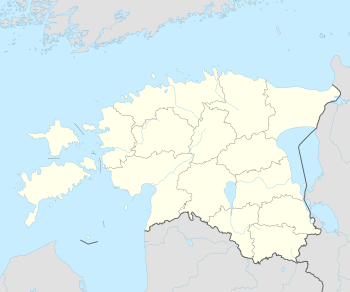Ruusmäe
| Ruusmäe | |
|---|---|
|
Rogosi manor in Ruusmäe village, view from the courtyard | |
 Ruusmäe | |
| Coordinates: 57°38′24″N 27°5′3″E / 57.64000°N 27.08417°ECoordinates: 57°38′24″N 27°5′3″E / 57.64000°N 27.08417°E | |
| Country | Estonia |
| County | Võru County |
| Time zone | EET (UTC+2) |
Ruusmäe is a settlement in Haanja Parish, Võru County in southeastern Estonia.[1]
Rogosi manor
Rogosi estate (German: Rogosinsky) in Ruusmäe village was founded circa 1600, during the Polish time, by the Polish nobleman Stanislav Rogosinsky.[2] This first edifice was probably made of wood and smaller than the presently visible main building.[3]
The estate belonged to the von Liepsdorff family between 1629 and 1776, and during their ownership the current building was constructed. It was heavily reconstructed in the 19th century, when it belonged to the von Glasenapp family. In 1918–20 the estate was nationalised during the sweeping land reforms that followed the Estonian Declaration of Independence. The son of the last owner, Guido von Glasenapp, was given compensation in the form of another farm in recognition for his service during the Estonian War of Independence. The manor was, however, left empty and fell into ruins during the 1920s.[3] In 1930–34, it was renovated and put into use as a school. A restoration was carried out in 1989–1991[3] and again in 1999.[2]
The manor is open to the public and houses a school,[2] guest house, and a local museum.[4]
References
- ↑ "NGA GeoName Database". National Geospatial Intelligence Agency. Archived from the original on 2008-06-08. Retrieved 2008-07-09.
- 1 2 3 "Rogosi Manor". Estonian Manors Portal. Retrieved 6 December 2013.
- 1 2 3 "Rogosi manor" (PDF). Visit Voru. Retrieved 6 December 2013.
- ↑ "Rogosi manor". Rogosi Manor. Retrieved 6 December 2013.
External links
 Media related to Rogosi manor at Wikimedia Commons
Media related to Rogosi manor at Wikimedia Commons- Satellite map at Maplandia.com
- Rogosi Manor Official site

